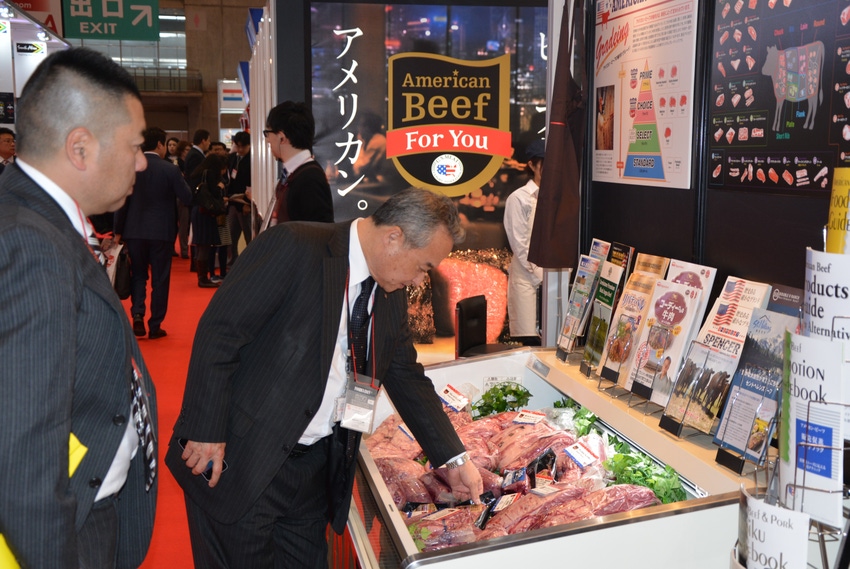Once the TPP between the 11 remaining countries is implemented, the U.S. will be the only major beef supplier to Japan that is still subject to quarterly safeguard mechanisms and higher tariff rates.
December 8, 2017

The 11 remaining members of the Trans-Pacific Partnership (TPP)* recently announced plans to move forward with a modified version of the agreement. If this agreement, now known as the Comprehensive and Progressive Agreement for Trans-Pacific Partnership (CPTPP), is implemented without the United States as a participant, it will create significant tariff rate advantages for the major competitors of the U.S. beef industry.
The U.S. has free trade agreements in place with several CPTPP countries, but the key exceptions are Japan and Vietnam. While Japan is the leading volume and value market for U.S. beef, it imposes the highest tariff rate – 38.5% – of any major import market.
The only major beef supplier that currently enjoys a lower rate is Australia, which gained some degree of tariff relief through the Japan-Australia Economic Partnership Agreement (JAEPA), which entered into force in 2015. Among smaller suppliers, Mexico and Chile also made market access gains for beef in their respective EPAs with Japan.
Japan’s imports of Australian beef are currently subject to tariffs of 29.9% for chilled beef and 27.2% for frozen. These rates are scheduled to fall to 23.5% by 2028 for chilled beef and 19.5% by 2031 for frozen.
Another important aspect of the JAEPA is that imports from Australia are no longer subject to Japan’s quarterly safeguard mechanisms, but rather are covered by country-specific annual safeguards, which are much less likely to be triggered. The EPAs with Mexico and Canada include tariff rate quotas, within which imports pay a reduced duty rate (about 30%), and are also excluded from quarterly safeguards. Japan’s frozen beef safeguard was recently triggered, resulting in a significant tariff rate increase (from 38.5% to 50%) on imports from the U.S., Canada and New Zealand. The higher rate is in effect from Aug. 1, 2017 through March 31, 2018.
Under CPTPP, Canada and New Zealand will benefit from the shift to annual import safeguards in Japan and their tariff rates will immediately drop to those currently paid on Australian beef. All participating beef suppliers serving Japan (including Australia) will see import tariffs drop to 9% over a period of 15 years – much lower than the 23.5% and 19.5% floors negotiated in Australia’s bilateral agreement.
The bottom line is that once the CPTPP is implemented, the U.S. will be the only major beef supplier to Japan that is still subject to quarterly safeguard mechanisms and higher tariff rates.
“This year, U.S. beef exports to Japan will account for about $1.8 billion of our $7 billion in total exports, so this is the market where we clearly have the most at stake,” explains U.S. Meat Export Federation Economist Erin Borror. “Japan’s 38.5% tariff rate and safeguard mechanisms have always been obstacles, but they impacted all major beef suppliers equally. That already began to change with implementation of the Japan-Australia EPA in 2015, and now the competitive landscape will be even more difficult.”
Vietnam is a growing market
Vietnam’s beef import tariffs will be eliminated in three to eight years under CPTPP. The current duty rate for chilled/frozen muscle cuts entering Vietnam is 20% and the rate for beef offal is 15%. Last year, U.S. beef and beef variety meat exports to Vietnam were 6,211 metric tons (mt) valued at just over $40 million. Exports have accelerated in 2017, with volume through the first three quarters of the year nearly doubling over last year’s pace to 7,298 mt and value up 81% to $42.1 million.
Through an existing free trade agreement with the Association of Southeast Asian Nations (ASEAN), Australia and New Zealand already have reduced tariffs for beef entering Vietnam, with all duties set for elimination by 2018 and 2019, respectively.
Through September, Australia’s exports to Vietnam were down 29% from a year ago to 5,276 mt, but still improved 12% in value to $25 million. Through October, New Zealand’s exports to Vietnam were down sharply year-over-year in volume (790 mt, -49%) but steady in value at $3.8 million. Canada’s exports to Vietnam (through September) were 485 mt valued at $2.3 million.
“Vietnam is a promising market in which U.S. beef has been gaining momentum,” Borror said. “But with two major competitors set to gain duty-free access and other suppliers making gains through CPTPP, it tempers the outlook for future growth.”
*The full list of CPTPP participants is: Australia, Brunei Darussalam, Canada, Chile, Japan, Malaysia, Mexico, New Zealand, Peru, Singapore and Vietnam.
Schuele is vice president, communications, with the U.S. Meat Export Federation in Denver, Colo.
About the Author(s)
You May Also Like



